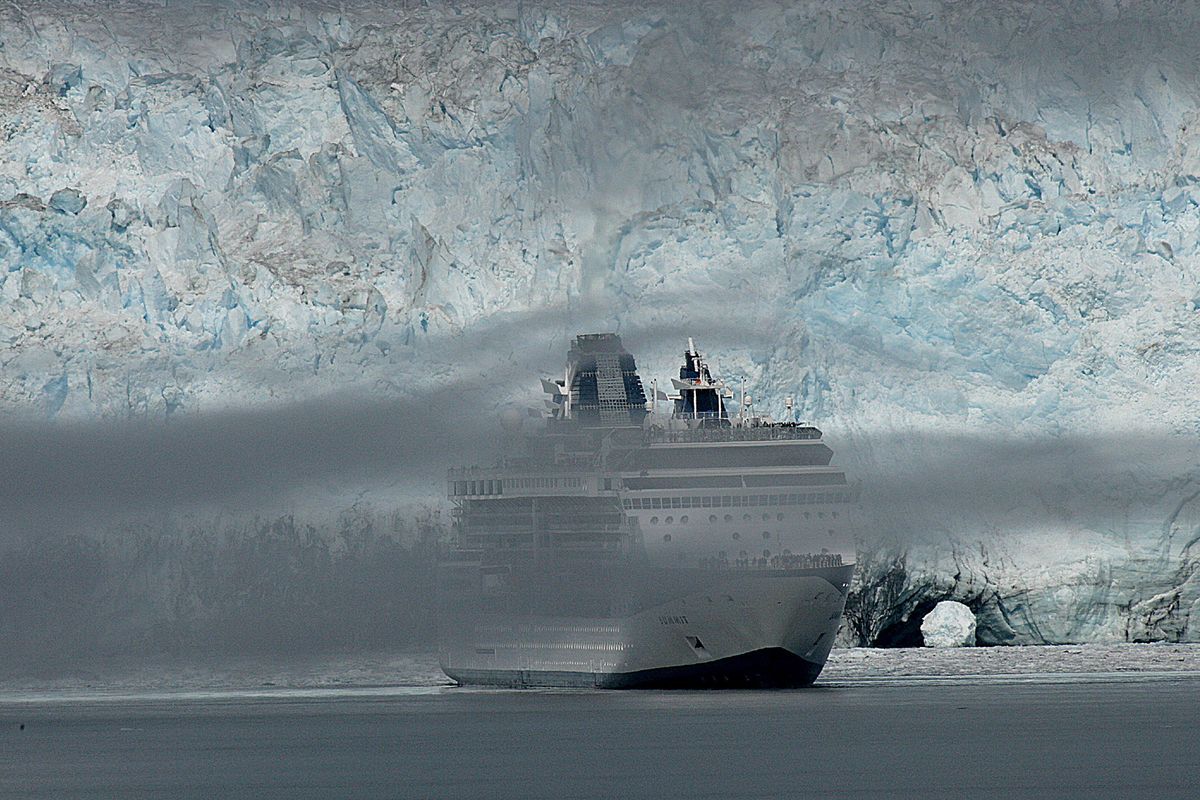Seals may reroute Alaska cruise ships
Path to glacier puts stress on pups, say NOAA scientists

ANCHORAGE, Alaska – Federal scientists are recommending rules that could restrict cruise ship visits to Alaska’s Hubbard Glacier, the longest tidewater glacier in North America, because of the threat they pose to harbor seals, a marine mammal important to Native Alaskan subsistence hunters in nearby Yakutat.
Scientists from the National Marine Mammal Laboratory, part of the National Oceanic and Atmospheric Administration, say cruise ships making their way through Disenchantment Bay on their way to the glacier flush seals from ice floes into chilly seawater during critical pupping and molting periods.
Pups must bulk up on mother’s milk during four to six weeks of nursing to have a better chance of surviving their first winter, said wildlife biologist John Jansen, lead researcher for the study. It suggests measures as severe as a blanket exclusion of cruise ships during pupping and molting, covering May through August, a big chunk of the cruise ship season.
NOAA Fisheries rules makers said they “hope to move forward in the near future” on the recommendations, said Aleria Jensen, a marine mammal specialist in the protected resources division. “This is a high priority issue for us.”
Cruise ships and other elements of large-scale tourism went from a trickle to a boom in Alaska over the last three decades as tourists lined up to see the state’s wonders from the warmth of a train car, a bus or a floating four-star hotel.
Alaska has become a major cruise destination, with 8 percent of the world capacity, the third-highest share, according to the study, behind the Caribbean’s 36 percent and the Mediterranean’s 16 percent.
Southeast Alaska offers whales, fjords, mountain peaks and America’s largest national forest. The breathtaking Hubbard Glacier stretches 76 miles to Mount Logan in Canada’s Yukon Territory. At water’s edge, Hubbard Glacier is six miles wide and more than 300 feet high. Visitors near the face can watch chunks of ice break off, cracking like a shotgun. The slurry of ice provides resting places for one of the world’s largest congregations of harbor seals.
Traffic in the bay increased from about 15 ship visits in 1989 to 170 in 2007, according to the study, with as many as five ships in Disenchantment Bay visiting in one day. Alaska Cruise Association members made 133 trips there last year.
Harbor seals are the backbone of subsistence culture in Yakutat, said Caroline Powell, a former board member of the Yakutat Tlingit Tribe. Seals are eaten dried, smoked and canned. Oil was rendered and used to preserve food. Though it’s not used to preserve food anymore, oil is added to food for flavor – like soy sauce, Powell said.
Fish, berries, seaweed and shellfish are all important, she said, but are only available seasonally.
“The seal is there all the time,” she said.
Community officials have long feared the effects of cruise ships, said her husband, Larry Powell, a former Yakutat mayor. The National Park Service has jurisdiction on one side of the bay and the National Forest Service on the other, but neither of those agencies nor the NOAA Fisheries nor the Coast Guard has adequately monitored cruise ship activity in the isolated community perched between Alaska’s Panhandle and south-central region, Powell said.
The study tried to find out if interruptions by cruise ships strained seals. Researchers made their observations from on board cruise ships and in aerial surveys, Jansen said.
Seals stayed on ice when cruise ships were 600 meters away – about 5 1/2 football fields – but the number of animals hitting the water rose steeply as ships approached closer than 500 meters. Seals of all ages – 90 percent – were sent swimming when a cruise ship moved within 100 meters, or about 91 yards.
A typical harbor seal pup might spend 40 percent of its time in the water. The study concluded that a modest increase to 50 percent for younger pups required them to burn significant calories that might otherwise be devoted to building fat needed to make it through their first winter. The problem of burning too many calories in the water would be compounded if cruise ships interrupted nursing.
Cruise ships have a stated policy to avoid approaching seals closer than 500 meters. Researchers observed ships breaking that barrier 85 percent of the time.
“I can recall several conversations where the crew and the captain on the bridge were like, ‘Oh, well we didn’t see many seals this trip, huh?’ Meanwhile, we had racked up maybe 100 observations,” Jansen said. “So it was clear that they weren’t seeing what we were seeing.”
The study recommends that cruise ships stay 500 meters away from seals, especially during pupping, and carry trained observers to aid in selecting routes that don’t disturb seals. A blanket exclusion of ships during seal pupping and molting should also be on the table, Jansen said.
John Binkley, spokesman for the Alaska Cruise Association, said he was not aware that NOAA might be looking at new rules. Vessels continue to operate under voluntary procedures worked out in 2001 following meetings with the tribal council.
“We are always willing to work with NOAA or any other government agency to protect and preserve the resources and environment that visitors come to Alaska to experience,” he said by e-mail.
Jensen, the marine mammal specialist, said the “take” provision of the Marine Mammal Protection Act outlaws killing or harassing seals. “When you have an obvious change of behavior, we interpret that as a ‘take,’ like a seal flushing from an iceberg.”
Jensen said regulators must decide whether new rules will apply only near Yakutat or at other glacial fjords.
“At this stage the agency certainly recognizes that additional conservation measures are needed to protect harbor seals, particularly in glacial habitats, as this study has indicated.”